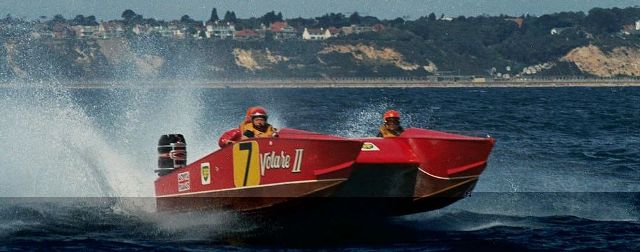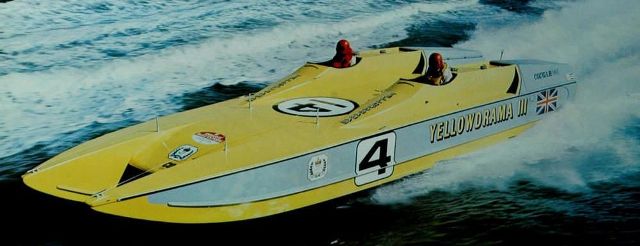An interview with Clive Curtis courtesy of David Sewell – Raceboat Magazine
|
Sitting in the lounge of Clive and Anne Curtis’ house, overlooking Southampton Water, it was like reading one of those books you can’t put down, as Clive recounted his experiences and participation in powerboat racing throughout most of his life, and revealed a vast knowledge of the sport and its history. Who would believe that the man behind the internationally acclaimed Cougar brand is in actual fact a genuine Cockney, born in 1933 within earshot of London’s Bow Bells. Had the family not moved to Essex, and when, at the tender age of nine Clive became a fully fledged member of the Sea Scouts, Cougar Racing may never have emerged to be one of the main influences in the history of British powerboat racing. In his formative years, a competitive nature was already beginning to flourish as Clive enjoyed taking part in many motorcycle scrambling races and he also took a few spins around the speedway race track at Rye House. However, motor cycling was for those who liked getting their hands dirty and being covered in mud, so sailing soon became a passion in his very first boat a Sharky 14 foot sailing dinghy built by himself. He took up the sport competitively with the Banelagh Sailing Club, Putney and one very significant victory was in the Merlin Rocket class when against 90 rivals on the Thames; Clive collected the winner’s trophy. Little did I know at the time, but in the late 1950’s when I would travel to Earls Court Boat Show with my father, as we approached London we used to pass a boating shop on the main road near Hammersmith. On the roof of the building was a Merlin Rocket and the company was C&B Marine founded by Clive Curtis and Robin Beauclair, which initially specialised in repairing alloy masts for Proctor. Until 1959 outboards built in the USA were not available in the UK as the government would not issue an import licence, but in 1959 all that changed and C&B became dealers for American built Owen Sportsboats and Evinrude outboards. At the time the only recognised powerboat racing in the UK featured hydroplanes but when Clive struck up a friendship with Geoff Tobert, the importer of Owen Boats and Gales Outboards, it heralded the beginning of a new era in powerboating. As a publicity stunt Clive and Geoff set off to set a new world speed record from Putney to Copenhagen, Denmark in a Healey Corvette speedboat powered by two Gale 40hp outboards. The duo made it to Denmark but because of an impending gale they never got to Copenhagen before heading back to Putney. A customer came into C&B Marine’s showroom and saw the Owens Kent with stickers on the screen saying ‘London to Denmark and back’, he said to Clive, "I like the look of that boat if you can take me to Calais and back in it I will buy the outfit"! That client was Edward Elliott, an artist and he wanted to make sketches of the Thames riverside scenery for future paintings. (Clive has two of Elliott’s paintings of the Thames hanging on the walls of his lounge). Naturally, Clive agreed to the proposal and drove Elliott to Calais via Ramsgate and on their return to Putney Edward purchased the outfit which was named Aramis. After hearing about Clive’s exploit Geoff Tobert put forward a challenge, "You think you are clever crossing to Calais and back but I bet you a fiver that I will beat you in a race across the channel." News of the challenge soon circulated around other boat dealers and instead of just a head to head, Curtis-v-Tobert, the first Putney to Calais via Ramsgate race attracted an estimated 27 entries. The idea was that the first boat home with a bottle of champagne signed by the landlady of a well known winery in the French port would be the winner. Needless to say Clive and navigator Brian Brain won the inaugural race whilst Tobart and navigator Ray Bulman, (Ray was a communication engineer at the time before becoming the famous powerboat racing journalist we all know and love) filled the runner-up berth. The first Putney-Calais race also initiated the formation of Britain’s first racing powerboat club UKOBA and the first Secretary was Ted Marsh of University Marine, distributors of Evinrude outboards at that time. In 1967 Clive founded Swordfish Marine at Twickenham, Middlesex and the aim of the company was initially to rig powerboats at a time when racing in the UK was still in its infancy. The company soon established itself after building a boat for Lady Arran, one of Britain’s most famous offshore racers. The first of Lady As ‘Badger’ raceboats, fitted with OMC V4 GT, went like a rocket and several Badger’s followed. It was at that time a gentleman walked into Clive’s workshops and announced that he had purchased a Levi monohull and he wanted a suitable engine for it. That gentleman was James Beard and his Levi monohull was called Volari. Clive and James struck up a friendship and together with Chris Hodges formed the company Cougar Powerboats based at Twickenham. After moving to Hounslow where many Cougar monohulls were produced, the first Cougar multihull arrived, a three-pointer that proved to be a real handful. Much to my surprise Clive then revealed the first Cougar catamaran was built in Guernsey on the Channel Islands. Apparently, James was fascinated with catamaran design but was aware that the cats being built at the time were in the habit of breaking up, Clive suggested they build a strong deck and fit the sponsons to the deck as if the rig was running on skis fitted to the underside of the main structure. The Guernsey built catamaran Volare was built using that method and fitted with a Mercury outboard proved to be a huge success. |
|
|
Volare – Photo Graham Stevens |
|
Cougar Powerboats moved to Netley, a small village in Hampshire and was soon producing highly successful cats. During 1973 Wiggins Teape, a 4 engined rig, was launched and three years later Ken Cassir’s Class I catamaran Yellowdrama set a new world speed record of 95 mph over a measured mile of the Southampton waters, now overlooked from the lounge of Clive and Anne’s current home. (Clive revealed that in 1933 a member of the BPBRDA set a speed record over the same course of over 1OOmph, but the boat was fitted with multiple engines of vast horsepower). While Cougar powerboats were being produced in large numbers Clive and Anne were also raising a young family – daughter Lesley Anne followed by Steve in 1964. |
|
|
Yellowdrama III – Photo Graham Stevens |
|
The Cowes-Torquay-Cowes marathon, launched in 1961 by Sir Max Aitkin (Anne was Sir Max Aitken’s PR lady), was the event every racer from all corners of the world wanted to win and Clive competed in at least five races himself. In 1969 he partnered the legendary Don Aronow to success in the race aboard Cigarette. Clive fondly recalls,’ Anne and I were enjoying dinner at a local restaurant following the gruelling race when Aronow came up to our table. He said he was off to the airport as he had to fly straight back to the US but thanked me for an enjoyable race. As the evening went on diners were coming over to shake my hand and thanking me. I thought they were congratulating me on winning the race but Don had paid for all the diners’ meals in the restaurant and told the cashier to tell them it was me who had paid their bills’. During the 1980s the Cougar empire opened a yard in Miami, Florida and the winners kept coming. Right up to the early-1990s Cougar won world championships every year together with countless national awards. A 15 year old Steve Curtis was shipped off to Cougar US to serve his apprenticeship and it was there that young Curtis Jnr rubbed shoulders with the good, the bad and the ugly of America’s offshore scene as he was initiated into the sport that was to take him to the ultimate success of Class I World Champion. The 198Os also witnessed Cougar Powerboats moving to another location at Hamble Point and a new name on the board of Directors, Ted Toleman. Mr Toleman had been a client of Cougar having raced a Class I mono and cat under the Toleman Group banner and in 1980 he acquired a 60% stake in the business. |
|
|
Aluminium Class 1 Cougar Catamarans in the early 1980’s – Photo Graham Stevens |
|
Cougar then diversified. Their aluminium fabrication division, which was set up for building high speed catamarans, was commissioned to construct a 12 m yacht to challenge for the America’s Cup. The White Crusader Challenge. Steve Ridgeway, (now CEO of Virgin Atlantic) had joined the staff of Cougar during a period when the company constructed possibly the most well known craft in their history, The famous "Virgin Challenger" She was launched in 1985 in a blaze of glory with Richard Branson’s recently launched airline Virgin Atlantic being the main sponsor of the project. The Atlantic crossing attracted extensive international media coverage, but sadly with the finishing post almost in sight the superb 32 ton aluminium catamaran capsized and sank. It was reported to have hit an underwater object all the crew including Branson were saved. In its long and illustrious history Cougar Powerboats has endured many ups and downs as the powerboat market changed dramatically over the years, but for me Clive Curtis had changed very little. |



